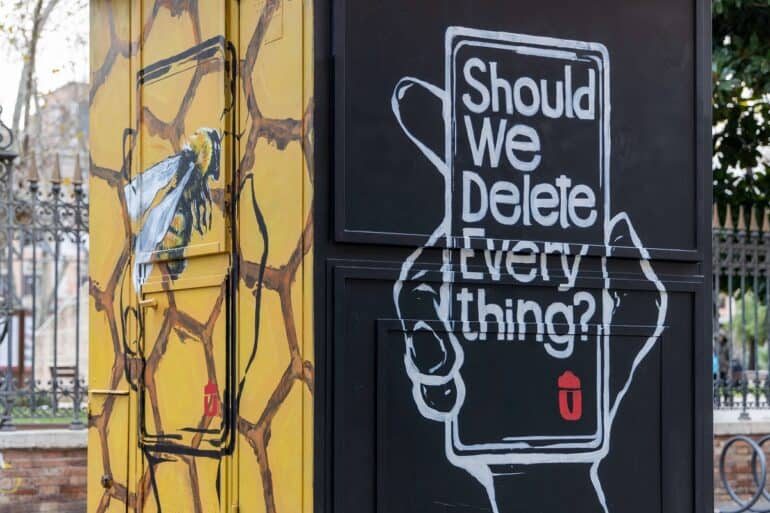Six artists redesigned the disused cabins of the local police; each cabin reveals an important message while enhancing the cabin’s features
If you’ve noticed some police cabins around the city have been painted with vibrant colors and unique designs, you might be wondering who did this or why …
This project, known as Cabin Art, was created by the Office of Purpose Youth Policies to show how urban art and social inclusion can become one. It brings life to the streets, reminding people of the beauty and uniqueness of Rome.
Booth 1
“Up to You” by Biceluna (Federica Mancini)
Piazza Vittorio Emanuele II
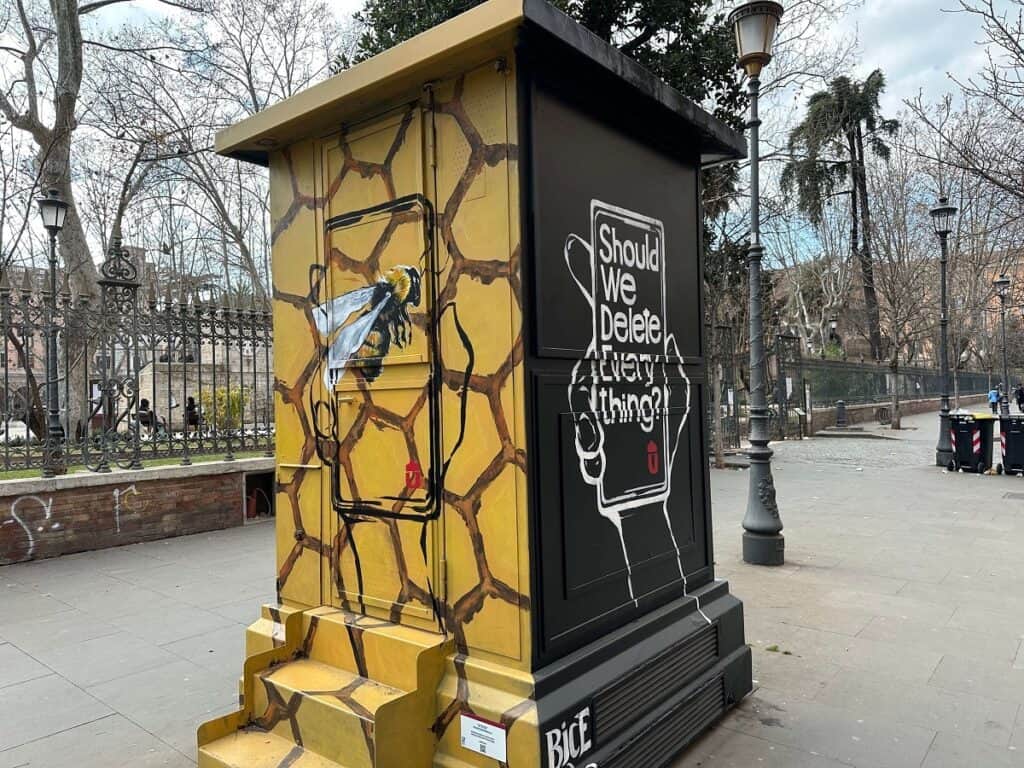
Biceluna’s (Federica Mancini) stand is called Up to You. The booth represents the deterioration of the Earth’s land, glaciers, and animals. People are used to seeing these places through technology rather than experiencing them in person, but one day we may no longer have these places, so it is important to visit them now and do what we can to preserve them for future generations.
To this end, the artist left a message on the side of the artwork, which reads “Should we delete everything?”, highlighting our addiction to technology and the way it distracts people from the reality of what is happening in the world. It is up to you to do your part and make eco-friendly choices so that you and others can see the beauty of existence.
Booth 2
“Ianus” by ADR (Andrea Piccinno)
Via Vico Jugario / Via Petroselli
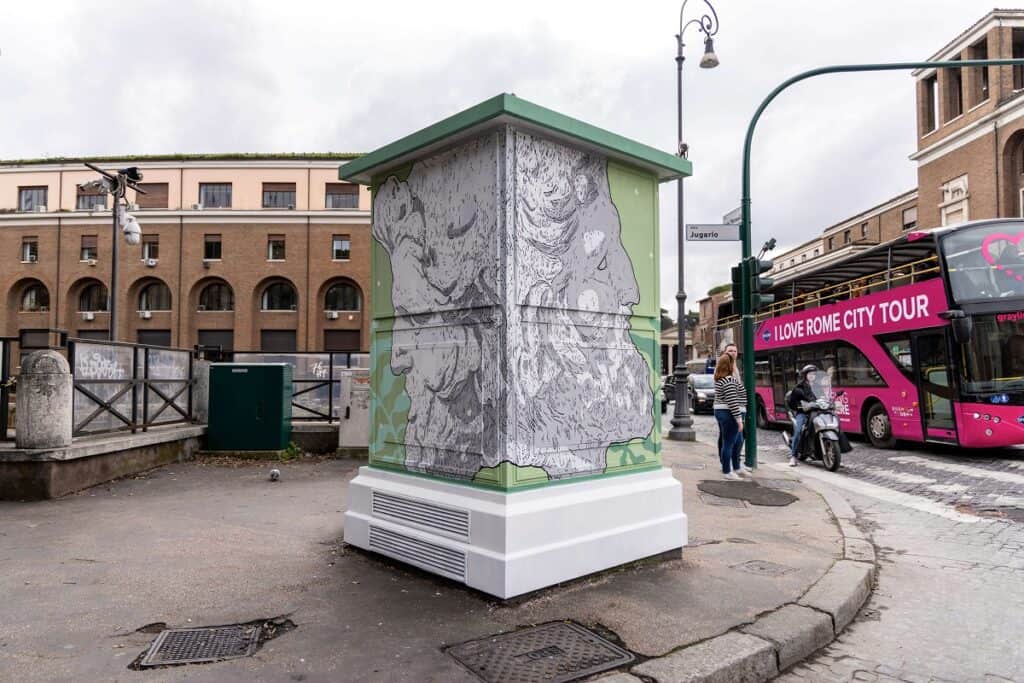
The second booth Ianus, was created by ADR (Andrea Piccinno), to symbolize the art, culture, and heritage of Rome.
There is a painting of Janus, the God of all beginnings, time, passages, and endings. Janus is seen to have two faces looking in opposing directions, one looking to the past and the other to the future. It is believed that Janus is in charge of the stages in life such as transitions from war to peace and births to deaths.
The location of the cabin is at the Vicus Jugarius, which connects the Roman Forum, the river Tiber and the ancient markets, creating a crossing point for these important places and thus evoking even more strongly the image of Janus as the deity of passages.
The artwork represents much more than just Janus and the passageways. It also showcases Janus gazing at the leaves, which represent nature, and an orange sphere that encapsulates the leaves, indicating a prevention of sustainable development.
The “Ianus” raises awareness of environmental issues and symbolizes a new beginning where nature is at the forefront of the Earth’s future. To see and understand the true meaning of the artwork, you would need to look at all the sides of the sentry box.
Booth 3
“Rifiorire” by Nian (Eugenia Chiasserini)
Via Casilina / Via di Tor Pignattara
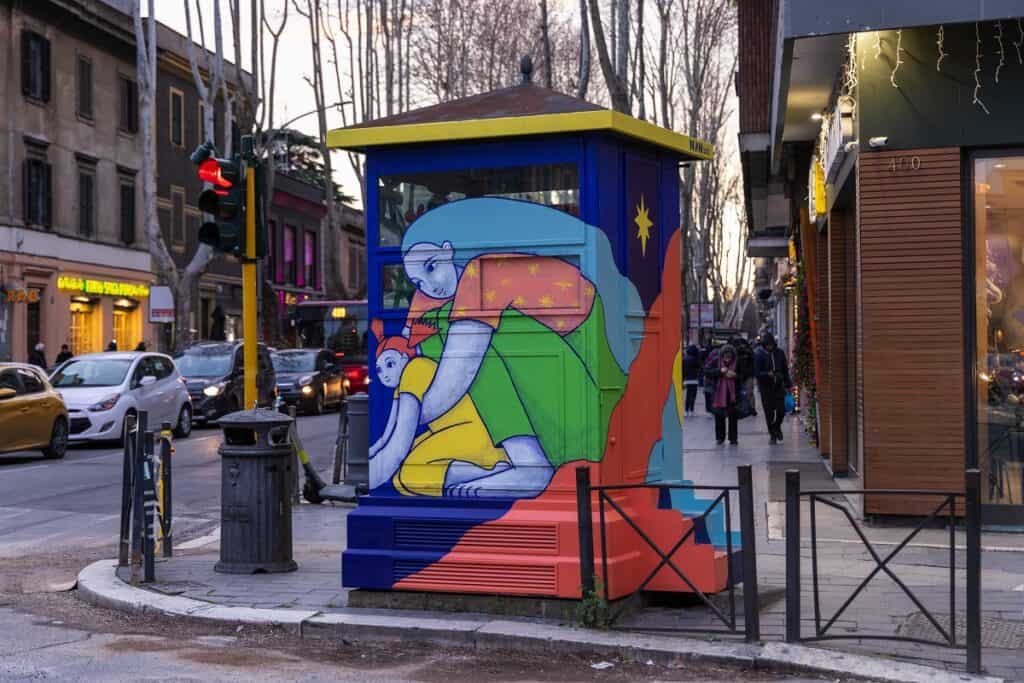
Rifiorire is the third booth, painted by Nian (Eugenia Chiasserini). Painted on this booth is the goddess of the ripening of grain (also known as the goddess of dawn), Mater Matuta, and the goddess of fortune and luck, Fortuna.
Mater Matuta and Fortuna’s Roman temples protected trade between the Romans, Greeks, Estrucans, Phoenicians, and Carthaginians. Nian decided to bring these two goddesses together to represent this historical context and value.
Booth 4
“To the Sound of Rome” by Leonardo Crudi
Piazzale Labicano
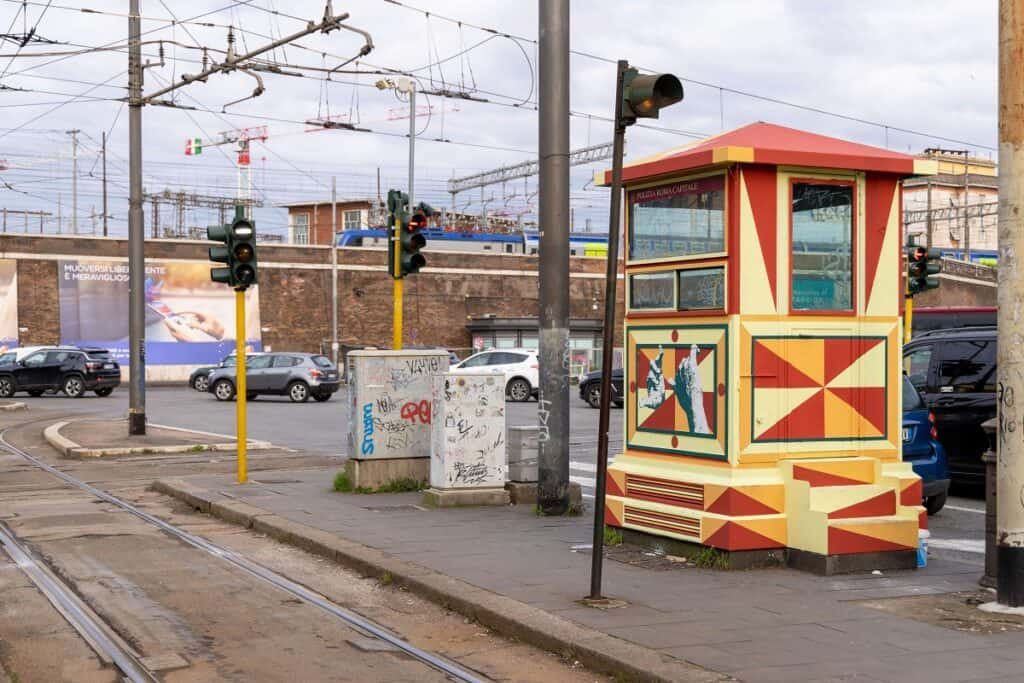
Leonardo Crudi created To the Sound of Rome, the fourth booth. Rather than curating a new message, Crudi enhances the cabin’s original features. He contrasts warm and cold colors in a way that emphasizes the cabin’s geometric design.
“To the Sound of Rome” features a unique pattern on each side of the booth. It retains the originality of the cabin which signifies that history will always be intertwined in Rome, even with the production of architecture and dwellings.
The contrast between warm and cold colors suggests an aesthetic dialogue between the city’s past and present. The cold colors reflect the original colors of the cabin, while the warm colors represent the ancient and modern dwellings of Rome.
Leonardo Crudi’s work is inspired by the various sounds around Rome. This work references Valentino Zeichen’s poem from the book “Passeggiate Romane” (2004). He highlights the various noises, silences, and tempos of the city, and emphasizes the interconnected nature of Rome’s contemporaneity and antiquity.
3-hour street art tour of Rome on the back of a Vespa
With our Street Art Vespa Tour of Rome you can enjoy a day of your holiday discovering the unconventional side of Rome in a cool way. Get your camera ready for the most unconventional Rome you would ever imagine!
Booth 5
“The Pinkish Box” by Vittorio Pannozzo
Circonvallazione Gianicolense / Via Ottavio Gasparri
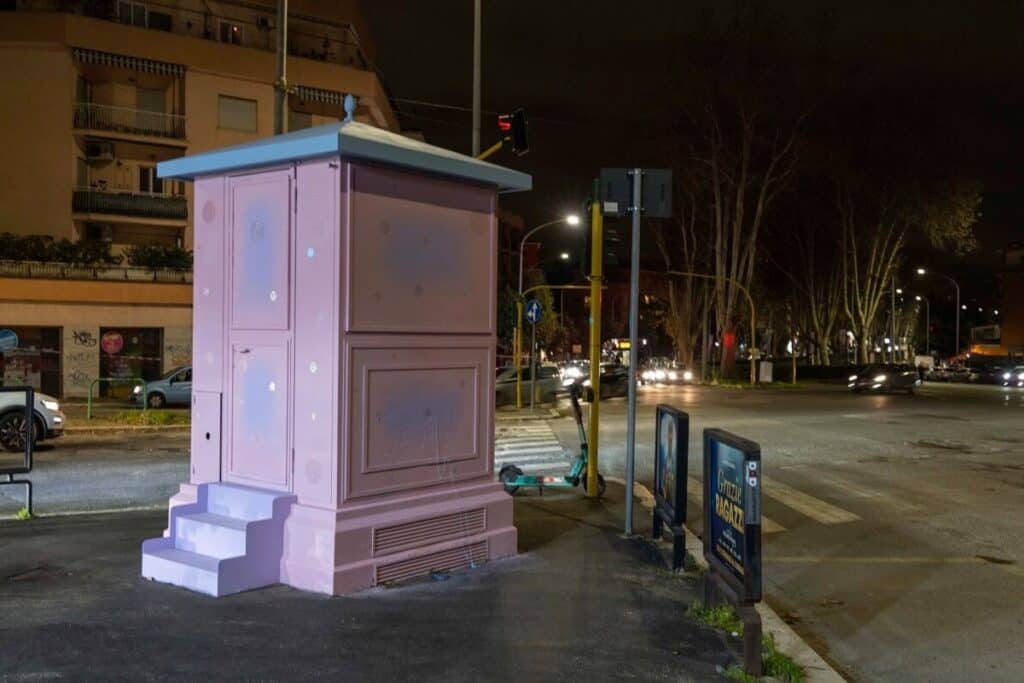
Booth five is named The Pinkish Box, designed by Vittorio Pannozzo. Pannozzo wanted to bring new life to the cabin, painting it with hues of blue, pink, and purple, a complete contrast to the box’s previous colors.
The mixture of these colors is used to disprove the notion that certain colors pertain to specific genders. Pannozzo incorporated these specific colors to create a feeling of openness and inclusion.
Booth 6
“Geometric Pattern” by Motorefisico (Lorenzo Pagliara and Gianmaria Zonfrillo)
Piazza di Villa Carpegna
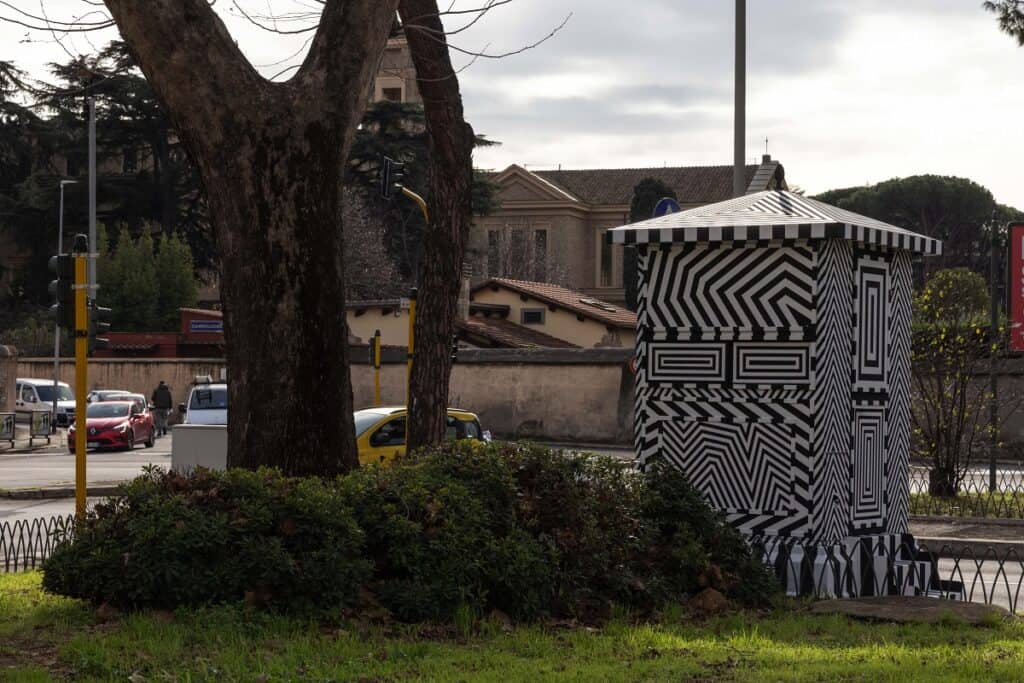
Motorefisico (Lorenzo Pagliara and Gianmaria Zonfrillo) created the sixth booth, Geometric Pattern. Pagliara and Zonfrillo were inspired by the geometric components seen in Roman mosaics, which hold a lot of historical significance. The history starts with the Roman mosaic, then moves towards the Michelangelo period, and continues into Carlo Maderno’s work.
“Geometric Pattern” enhances the original lines of the cabin, giving it new life and dimensions. The art is characterized by high stroke definition and color rendering.
INSPIRATION
Discover the best street art in Rome

